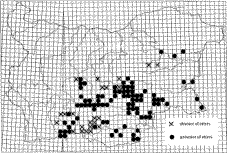 |
Last Update:
Thursday November 22, 2018
|
| [Home] |
|
Volume 22 Issue 1 Pages 1 - 44 (April 2005) Citation: Georgiev, D. G. (2005) Habitats of the Otter (Lutra lutra L.) in some Regions of Southern Bulgaria. IUCN Otter Spec. Group Bull. 18(1): 6 - 13 Habitats of the Otter (Lutra lutra L.) in some Regions of Southern Bulgaria Dilian G. Georgiev Departament of Ecology and Environmental conservation, University of Plovdiv, Tzar Assen Str. 24, BG-4000 Plovdiv, Bulgaria
INTRODUCTION The previous study of otter (Lutra lutra L.) distribution in Bulgaria was done by SPIRIDONOV and SPASSOV (1989). The inquiry method was mainly used, and the authors recommended a careful investigation of the population of the species in the country should be carried out. Some information on the distribution of the otter derived from studying its parasites was presented by YANCHEV (1987) and NIKOLOVA et al. (2001). GEORGIEV (2004) reported on materials in the food spectrum. The aim of the present study was to gather base information on the distribution and the relative number of otters in some habitats and regions, and thus to assist future monitoring of the species in Bulgaria. MATERIALS AND METHODS For the stratification census method (CAUGHLEY, 1977), base data on the distribution and possible relative quantity of a given vertebrate species from various habitats and regions is needed. To study the distribution of the otter the method of MACDONALD and MASON (1983, 2004) was mainly used and some observation and tracking was also done. Bank side areas smaller than 600 m were searched as a whole. For ponds and reservoirs, the upper and lower parts near the river were considered as sites for monitoring for several reasons: frequently dense vegetation, low disturbance, suitable bank slope for dens and possible home range border areas are present. Questioning of biologists and experts from NGO “Green Balkans” and “Trakiiski University” was undertaken too. A little information was gathered from them and from hunters, fishers and other people. Data was gathered during 1994-2005 from various habitats (total of 111 UTM-grid squires and 148 sites) in Rhodopy Mountain, Surnena Gora Mountain, Stara Planina Mountain, Sakar Mountain, Dervent Heights, Upper Thracian Valley, Tundza Valley, Kazanlashka Valley and Black Sea Coast. These regions were chosen as they are considered the parts of Southern Bulgaria with strongest otter population (SPIRIDONOV and SPASSOV, 1989). The census was taken mainly during the period of 01.03-10.07.2005. Three main habitat types were investigated (due to their relative abundance in the regions studied): reservoirs (dams, ponds, fishponds), middle size rivers and large rivers situated in Upper Thracian Valley. Fifteen reservoirs were searched and a total of 77,5 km of bank side from 4 middle size rivers and 45 km of one large river (Maritza) were surveyed for food availability. A combination of methods was used, and some adaptations were made: mean spraints per sprainting site were considered (CHANIN, 2003), and compared to the results from observations or from the method of SIDOROVICH (1991) wherever possible. The mean spraints per sprainting site around dens, hunting sites or home range overlaps and other marking site-types were analyzed separately from each other. The intensity of marking was related with the number of individuals indicated by tracks and observation, and the data for the Bulgarian conditions during the study period was extracted. In rare cases only the tracking method was used. The number of individuals was calculated as individuals with marking behaviour (subadults and adults) per 10 km of river or 0.5 km2 reservoir water surface, and for rivers only, possible resident females per 10 km. The home range overlaps of the possible resident females were determined according to the papers of ERLINGE (1967, 1968), VSHIVCEV (1967, 1972) and MASON and MACDONALD (1986). To study the habitats, the vegetation (trees, bushes and littoral plants), bank slope and disturbance levels were rated up to 10 meters away from the water. At river sites these characteristics were considered in 200-meter transects along the route for both banks, and then calculated for the whole route. At dams and ponds the whole territory was looked at. For vegetation dominance and levels of disturbance a 5-point scale was used following papers of MASON and MACDONALD (1985) and OTTINO et al. (1995). For the bank slope assessment (which we suppose is important factor for the den making) a 3 point scale was used as follows: 1 (0º-30º); 2 (30º-60º); 3 (>60º) was chosen and only the dominant slope category was recorded in the transect. Presence or absence of other suitable habitats up to 3 km away from the studied one was recorded To categorize the habitat types the classification of SIDOROVICH (1995) and also the map base of NGO “Green Balkans” was used. For the observations a binocular and a night vision monocular (model Yukon, NV Tracker 2.5x42) were used, and for marking otter signs and habitat study, a GPS (model Garmin, E-Trex Summit). Most of the trips made were financed by various projects of NGO “Green Balkans”. RESULTS AND DISCUSSION The otter was found in 88 UTM-grid squares, in various habitat types (constantly inhabited or temporary usage), see Fig.1. The species was not recorded in 23 UTM-grid squares in the highest mountainous areas: Stara Planina Mountain (LH32, LH82, MH44, MH64); Western Rhodopy Mountain (GM32, GM44; KG74; KG54, KG70, KG91, KG90, LG00, LG10, LG11, LG12, LG22, LG23, LG33, LG31); Sredna Gora Mountain (KH82, LH40, LH50, LH80). This was where the rivers present were without fish and ponds froze long term during winter.
According to the information gathered, the following habitats were considered as important for otters in the regions studied in Southern Bulgaria: 1. Main habitatsHabitats where otters could live during most time of the year, providing constant food and shelter for the resident animals; in some cases combinations of these habitats could support otters in this way. 1.1 Running waters 1.1.1 Middle sized rivers -rivers from 2 up to about 15 meters wide and not more than 2 meters deep, not freezing during winter. Often various suitable habitats are present.
1.1.2. Large rivers – rivers wider than 15 m, and up to about 0.5 km. Often various supporting habitats are present.
1.2. Standing waters 1.2.1. Middle size reservoirs – Not freezing during winter, or only doing so partly or for short time. These habitats were monitored at their parts nearest the river, and 100% effectiveness was gained. In all the sites spraints were found, except one case, but there tracks were recorded. Sometimes with no adjacent suitable habitats.
1.2.2. Large reservoirs – same characteristics as the middle size ones. The difference was that in dams in hilly areas, there were sites with almost no disturbance at all . In hilly areas, the only suitable adjacent habitat was the river, but in the plain areas, there were diverse supporting habitats present.
1.2.3. Saline lagoons and coastal lakes – lack of bush and tree bank vegetation, but dense littoral vegetation, sometimes with high disturbance, shallow banks. Two lakes visited, positive (NH31, NH51). Supporting habitats were flooded areas and soil bank canals, connecting the lake with the sea. 1.2.4. Black Sea coast rocky areas – one site visited and otters found (NG67). High disturbance, no dense vegetation marked. In this case the only supporting habitat was small freshwater river, flowing in the sea, but no otter signs were recorderd there. 2. Supporting habitats These could not be inhabited by otters during the whole year, but could temporarily provide some extra food and space during warm seasons and enhance the carrying capacity of the main habitats. Some of them assist the migration and travels of otters between different sites. When not combined each other or with main habitats often no otter signs recorded. 2.1. Running waters 2.1.1. Small canals with soil banks – Poor bank vegetation, but often dense littoral one, high disturbance, slow running waters, sometimes polluted. Use by otters recorded at three sites: Upper Thracian Valley (LG07, LG99) and Kazanlashka Valley (MH01). 2.1.2. Middle size cement bank canals constantly filled with water – Poor vegetation on banks, no littoral vegetation, fast running water, presence of fish, moderate disturbance, often with no proper bank material for den making. After further investigations, this habitat type possibly could be classified as “main”, if resident animals were found. Otters recorded at 4 sites: Upper Thracian Valley (LG99, LG17, LG06). 2.1.3. Streams and small rivers – Clean water, often dense vegetation and low disturbance. Because of the very constant marking recorded near reservoirs, we consider this habitat type is important for migrations and travels. In rare cases otter signs were found over 200 meters up or downstream of the reservoir where it is very small, but in one case a den was found 57 meters away from the dam (downstream). In another case, use of a pond 2,13 km away from the river was recorded, where a small stream which dried out during summer was the only connection. 2.2. Standing waters 2.2.1. Ponds and small reservoirs
2.2.2. Dunghill pit filled with water – one case, use of the food source of Perca fluviatilis inhabiting the pit (Upper Thracian Valley: LG06). Steep, unstable banks, high disturbance and pollution. 2.2.3. Rice fields – one case (Upper Thracian Valley: LG07), otter feeding site, two individuals recorded. Shallow banks, no tree or bush vegetation, high disturbance, no pollution. 2.2.4. Flooded areas – three sites searched, one positive (MG19, MG08, LG07). Shallow banks, no tree or bush vegetation, dense Phragmytes sp. or Typha sp. vegetation. Could provide some shelter and frogs as a food source, and sometimes fish. 2.2.5. Black Sea sandy beach areas – two sites positive (NH51, NG75). High disturbance and no places for hiding, but providing extra food from the sea. 2.3. Negatively human influenced waters 2.3.1. Clean running waters without fish – Middle size rivers in mountain areas, where the lack of fish is due to overfishing by humans, good bank slope and vegetation, low disturbance. From 25 sites visited, otters were found in 3 of them: Rhodopy (LG21) and Sredna Gora Mountains (MH00). 2.3.1. Polluted running waters – sometimes with dense bank vegetation and low disturbance, canalized banks, no fish and sometimes no frogs. Otters recorded in 4 sites in Upper Thracian Valley (MG19, MG09, LG99). This environment stratification and habitat classification was made for Rhodopy Mountain, Surnena Gora Mountain, Stara Planina Mountain, Sakar Mountain, Dervent Heights, Upper Thracian Valley, Tundza Valley, Kazanlashka Valley and Black Sea Coast, but could be used also for otter monitoring in other regions of Bulgaria. Other habitat types will have to be considered as well, like, for example, swamps, mountain lakes and the River Danube. CONCLUSIONS The otter was searched for in 111 UTM-grid squares. It was found in 88 and absent from 23 of them. On the basis of otter presence or absence, possible otter numbers, and various environmental features, a total of 23 habitat types and human influenced otter habitats were divided and classified for Southern Bulgaria to assist future monitoring. The environment stratification and habitat classification was made for 5 mountains, 3 valleys and the Black Sea Coastal region. ACKNOWLEDGEMENTS - We deeply thank Prof. Nikolai Spassov (National Museum of Natural History) and Prof. Christopher Mason (Essex University) for the papers sent and their valued advice and help, to Slaveia Stoicheva, Hristo Nikolov, Evgenia Dobreva, Doncho Kirov, Elena Tilova, Ilian Stoev, Georgi Dulev, Georgi Dilovski, Liubomir Yankov, Ivailo Klisurov, Nikolai Arabadziev, Stefan Kjurkchiev, Gradimir Gradev and many other members of NGO “Green Balkans” co-operating during the study. Our thanks also go to Dr. Evgenii Raichev (Trakiiski University) for his friendly support during the whole work. REFERENCES CAUGHLEY, G. (1977) Analysis of vertebrate populations. Wiley-Interscience Publ., London, New York, Sydney, Toronto, 357 pp. Résumé : Habitats de la Loutre (Lutra lutra L.) dans Certaines Régions du Sud de la Bulgarie
Resumen: Hábitats de la Nutria de Río (Lutra lutra L.) en Algunas Regions del sur de Bulgaria |
| [Copyright © 2006 - 2050 IUCN/SSC OSG] | [Home] | [Contact Us] |

